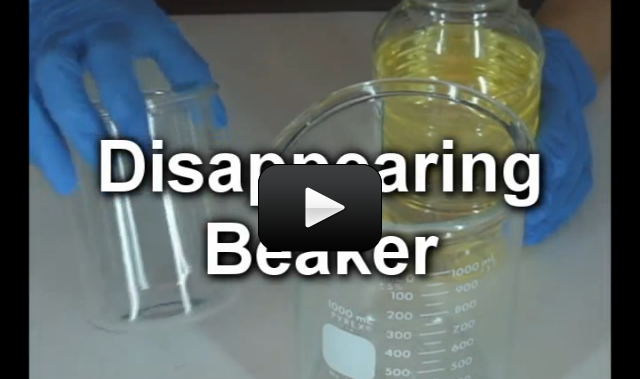We’re going to bend light to make objects disappear. You’ll need two glass containers (one that fits inside the other), and the smaller one MUST be Pyrex. It’s okay if your Pyrex glass has markings on the side. Use cooking oil such as canola oil, olive oil, or others to see which makes yours truly disappear. You can also try mineral oil or Karo syrup, although these tend to be more sensitive to temperature and aren’t as evenly matched with the Pyrex as the first choices mentioned above.
Here’s what you need:
- two glass containers, one of which MUST be Pyrex glass
- vegetable oil (cheap canola brand is what we used in the video)
- sink
Published value for light speed is 299,792,458 m/s = 186,282 miles/second = 670,616,629 mph
[am4show have=’p8;p9;p11;p38;p92;p10;p37;p66;’ guest_error=’Guest error message’ user_error=’User error message’ ]
When a beam of light hits a different substance (like glass), the speed of light changes. The color of the light (called the wavelength) can also change. In some cases, the change of wavelength turns into a change in the direction of the beam.
For example, if you stick a pencil is a glass of water and look through the side of the glass, you’ll notice that the pencil appears shifted. The speed of light is slower in the water (140,000 miles per second) than in the air (186,000 miles per second), called optical density, and the result is bent light beams and broken pencils.
You’ll notice that the pencil doesn’t always appear broken. Depending on where your eyeballs are, you can see an intact or broken pencil.
This is a very fine point about refraction: when light enters a new substance (like going from air to water) perpendicular to the surface (looking straight on), refractions do not occur.
However, if you look at the glass at an angle, then depending on your sight angle, you’ll see a different amount of shift in the pencil. Where do you need to look to see the greatest shift in the two halves of the pencil? (Hint: move the pencil back and forth slowly.)
Depending on if the light is going from a lighter to an optically denser material (or vice versa), it will bend different amounts. Glass is optically denser than water, which is denser than air.
Here’s a chart:
Vacuum 1.0000
Air 1.0003
Ice 1.3100
Water 1.3333
Pyrex 1.4740
Cooking Oil 1.4740
Diamond 2.4170
This means if you place a Pyrex container inside a beaker of vegetable oil, it will disappear. This also works for some mineral oils and Karo syrup. Note however that the optical densities of liquids vary with temperature and concentration, and manufacturers are not perfectly consistent when they whip up a batch of this stuff, so some adjustments are needed.
Not only can you change the shape of objects by bending light (broken or whole), but you can also change the size. Magnifying lenses, telescopes, and microscopes use this idea to make objects appear different sizes.
Questions to Ask
- Does the temperature of the oil matter?
- What other kinds of oil work? Blends of oils?
- Does it work with mineral oil or Karo syrup?
- Is there a viewing angle that makes the inside container visible?
- Which type of lighting makes the container more invisible?
- Can we see light waves?
[/am4show]


Is there a way to make the inside container where you can see it with out taking it out?